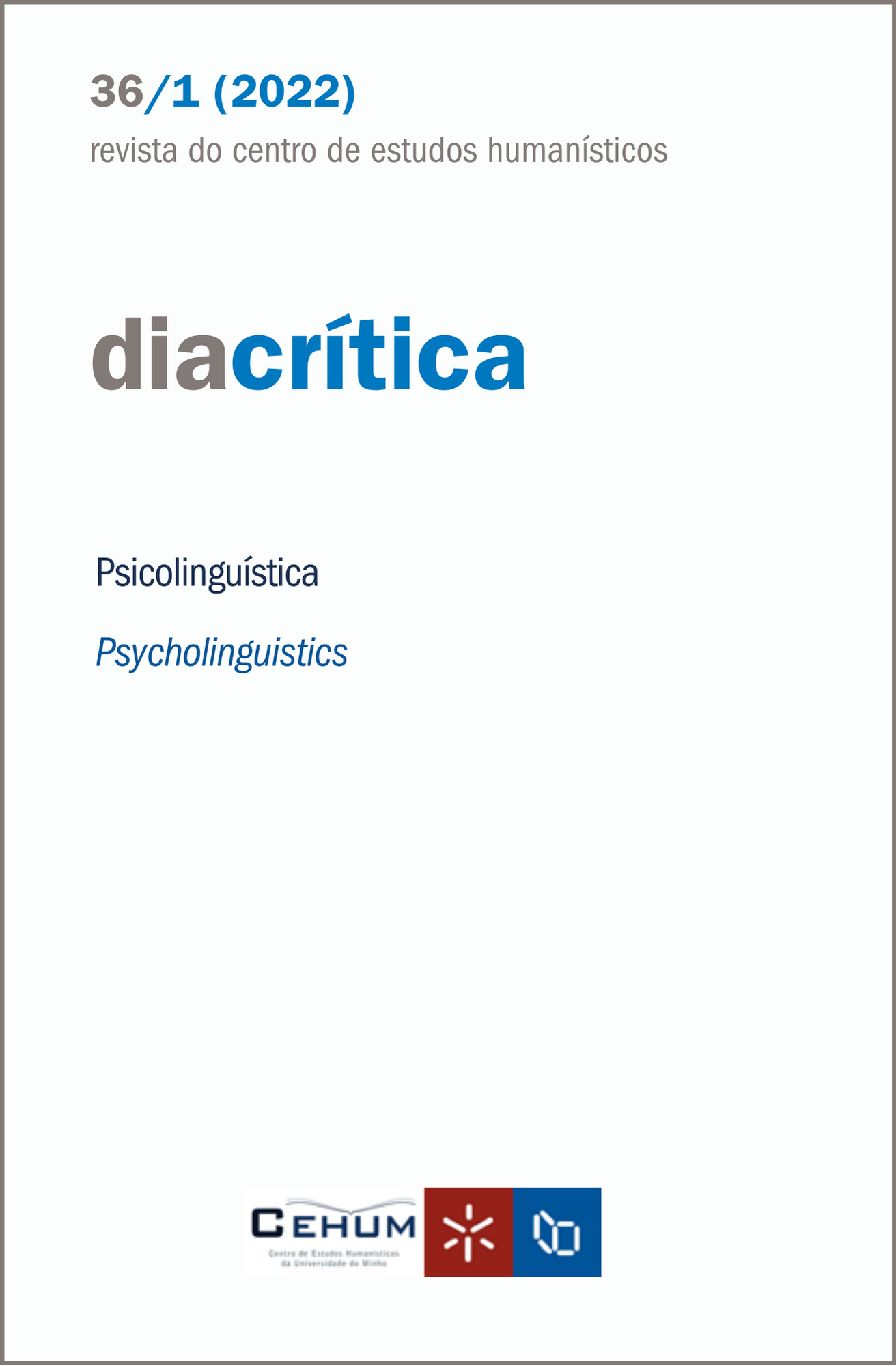European Portuguese L2 clitics acquisition and the feature reassembly hypothesis
DOI:
https://doi.org/10.21814/diacritica.4777Keywords:
Second language acquisition, Clitic pronouns, European Portuguese, Feature Reassembly Hypothesis (FRH)Abstract
The Feature Reassembly Hypothesis (FRH) suggests that the difficulties in second language (L2) acquisition happen when the learners have to reassemble the features present in their native language in order to present the L2’s configuration. This study aimed to test the FRH regarding the acquisition of clitics pattern in European Portuguese (EP) L2 and the acceptability of verbal responses, following Martins (1994), who correlates both phenomena with EP’s strong V-features. Divided into two different proficiency groups, 21 native speakers of Spanish executed two tasks: one of sentences completion and an acceptability judgment task of verbal responses. Differently to what has happened in other studies, preference for enclisis was lower. The analysis by proclitic context showed that the development of the placement patterns is not homogeneous, with negative contexts being produced in higher rates even at lower levels of proficiency. An evolution in the acceptance of verbal responses could be detected by the second task. Nevertheless, the statistical analysis did not show statistical correlation between results of the tasks. The conclusion is that there are signs that the FRH might be valid, but future research must be conducted in order to assess the nature of this reassembly.
References
Costa, A. (2018). Variação linguística e ensino de Português, Língua Não Materna: O caso dos pronomes átonos. Medi@ções, Revista OnLine, 6(1), pp. 147–161.
Costa, J. & Lobo, M. (2007). Clitic omission, null objects or both in the acquisition of European Portuguese? In S. Baauw, F. Drijkonongen, & M. Pinto (Eds.), Romance languages and linguistic theory 2005 (pp. 59–72). Amsterdam: John Benjamins. https://doi.org/10.1075/cilt.291.06cos DOI: https://doi.org/10.1075/cilt.291.06cos
Costa, J. & Lobo, M. (2009). Clitic omission in the acquisition of European Portuguese: Data from comprehension. In A. Pires, & J. Rothman (Eds.), Minimalist inquiries into child language acquisition. Case studies across Portuguese (pp. 63–84). Berlim/Nova Iorque: Mouton de Gruyter. https://doi.org/10.1515/9783110215359.1.63 DOI: https://doi.org/10.1515/9783110215359.1.63
Costa, J., Fiéis, A. & Lobo, M. (2015). Input variability and late acquisition: Clitic misplacement in European Portuguese. Lingua, 161, pp. 10–26. https://doi.org/10.1016/j.lingua.2014.05.009 DOI: https://doi.org/10.1016/j.lingua.2014.05.009
Costa, J., Fiéis, A. & Lobo, M. (2016). A aquisição dos pronomes clíticos no português L1. In A. M. Martins, & E. Carrilho (Eds.), Manual de linguística portuguesa (pp. 365–386). Berlin: De Gruyter. https://doi.org/10.1515/9783110368840-018 DOI: https://doi.org/10.1515/9783110368840-018
Duarte, I. (2003). Padrões de colocação dos pronomes clíticos. In M. H. M. Mateus et al. (Eds.), Gramática da língua portuguesa (pp. 847–867). Lisboa: Caminho.
Gu, W. (2019). Aquisição de pronomes clíticos de português europeu por falantes de chinês: Dados sobre a colocação. Revista da Associação Portuguesa de Linguística, 5. https://doi.org/10.26334/2183-9077/rapln5ano2019a14 DOI: https://doi.org/10.26334/2183-9077/rapln5ano2019a14
Ipek, H. (2009). Comparing and constrasting first and second language acquisition: Implication for language teachers. English Language Teaching, 2(2), pp. 155–163. https://doi.org/10.5539/elt.v2n2p155 DOI: https://doi.org/10.5539/elt.v2n2p155
Klee, C. A. (1990). Spanish-Quechua language contact: The clitic pronoun system in Andean Spanish. Word, 41(1), pp. 35–46. https://doi.org/10.1080/00437956.1990.11435812 DOI: https://doi.org/10.1080/00437956.1990.11435812
Laka, I. (1990). Negation in syntax. On the nature of functional categories and projections (Tese de Doutoramento, Massachusetts Institute of Technology, Cambridge).
Lardiere, D. (2009). Some thoughts on the contrastive analysis of features in second language acquisition. Second Language Research, 25, pp. 173–227. https://doi.org/10.1177/0267658308100283 DOI: https://doi.org/10.1177/0267658308100283
Madeira, A. M. & Xavier, M. F. (2009). The acquisition of clitic pronouns in L2 European Portuguese. In A. Pires, & J. Rothman (Eds.), Minimalist inquiries into child and adult language acquisition (pp. 273–299). Berlin/New York: Mouton de Gruyter. https://doi.org/10.1515/9783110215359.2.273 DOI: https://doi.org/10.1515/9783110215359.2.273
Madeira, A. M., Crispim, M. L. & Xavier, M. F. (2006). Clítico pronominais em português L2. In J. Barbosa & F. Oliveira (Orgs.), APL - Textos selecionados. XXI Encontro Nacional da Associação Portuguesa de Linguística, pp. 495–510. Lisboa: Colibri.
Martins, A. M. (1994). Enclisis, VP-deletion and the nature of Sigma. Probus, 6, 173–206. https://doi.org/10.1515/prbs.1994.6.2-3.173 DOI: https://doi.org/10.1515/prbs.1994.6.2-3.173
Martins, A. M. (2002). Tipologia e mudança linguísticas: os pronomes pessoais do português e do espanhol. In E. Raposo, & H. Sharrer (Eds.), Santa Barbara Portuguese studies VII (pp. 340–386).
Martins, A. M. (2013). A posição dos pronomes pessoais clíticos. In E. P. Raposo, M. F. Bacelar, M. A. Mota, L. Segura, & A. Mendes (Eds.), Gramática do português (pp. 2231–2302). Lisboa: Fundação Calouste Gulbenkian.
Martins, A. M. (2016). A colocação dos pronomes clíticos em sincronia e diacronia. Em A. M. Martins, & E. Carrilho (Eds.), Manual de Linguística Portuguesa (pp. 401-430). Berlin/Boston: De Gruyter. DOI: https://doi.org/10.1515/9783110368840-017
Santos, M. F. (2002). Os pronomes pessoais átonos no portugues europeu. Descrição de problemas que ocorrem no 3º ciclo e proposta de actividades didáticas (Dissertação de Mestrado, FLUL, Lisboa).
Shimanskaya, E. M. (2015). Feature reassembly of semantic and morphosyntactic pronominal features in L2 acquisition (Tese de Doutoramento, Universidade de Iowa, Iowa).
Shimanskaya, E. & Slabakova, R. (2015). Re-assembling objects: A new look at the L2 acquisition of pronominal clitics. Bilingualism: Language and Cognition, 20(3), 1–18. https://doi.org/10.1017/S1366728915000784 DOI: https://doi.org/10.1017/S1366728915000784
Soriano, O. F. (2015). Clíticos. In J. Gutiérrez-Rexach (Ed.), Enciclopedia de lingüística hispánica (pp. 423–436). Londres: Routledge. DOI: https://doi.org/10.4324/9781315713441-38
Downloads
Published
How to Cite
Issue
Section
License
Copyright (c) 2023 Ronan Pereira

This work is licensed under a Creative Commons Attribution-NonCommercial 4.0 International License.










